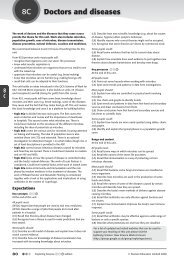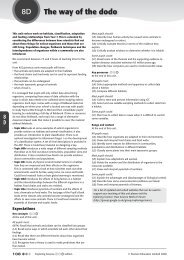8E TEACHER GUIDE.pdf - swallowhillresources
8E TEACHER GUIDE.pdf - swallowhillresources
8E TEACHER GUIDE.pdf - swallowhillresources
- No tags were found...
You also want an ePaper? Increase the reach of your titles
YUMPU automatically turns print PDFs into web optimized ePapers that Google loves.
What’s in a solution?<strong>8E</strong>dTopic task plannerUse these tasks to adapt the Exemplar topic plan to your own needs. Many tasks can be adapted to become different types (e.g. ‘starter’rather than ‘exploring’). AB or AB/AT at the top of a task means that the task depends on using the ActiveBook and/or ActiveTeach;where these symbols appear in brackets it indicates that the task can be carried out with or without their use.Also consider using one of the plenaries from the previous topic as a starter task in this topic.Task Level NC Type Objectives Skills 1 KC 2 KP 3 RC 4 COStarter 1 M/S 4–5 Practical 1, 3 2aStarter 2 M/S 4 Classwork PLTS (Ep) 2aExploring 1 M/S 4–5 Practical 1–5 1c, 2a? 2aExploring 2 M/S 4–5 Practical 1–5 1c, 2a 2aExploring 3 S/C 4–6 Practical 1–5 1a, 1c 2a cExploring 4 M/S/C 4–6 Classwork 5–7 ICT (IR) 2a cExplaining 1 M 4–5 Practical 5 2aExplaining 2 M/S 4–5 Classwork 1–5, 7 2a 2a cExplaining 3 M 4 Classwork 3 2aPlenary 1 M/S 4–5 Classwork 1–5 2aPlenary 2 M 4–5 Classwork 1–3 Lit (WF) 2aPlenary 3 M/S 4–6 Classwork 1–7, previous topics PLTS (Rl) 2aHomework 1 M 4–5 Homework 3 2aHomework 2 S 4–6 Homework 4, 5, 7 2a 2a cHomework 3 C 5–6 Homework 4, 5, 7 Lit (EC) 2a, 2b 2a c, j<strong>8E</strong>dStarters1: Practical: Chromatography introductionDemonstrate chromatography to the whole class as a starteractivity. Use a dark-coloured ink that includes a range of differentcolours to make the chromatogram more interesting (either testdifferent pens containing water soluble inks to find one with agood mix of colours, or make up a mixture of different colouredinks). If time is short, you may wish to have a ready-preparedchromatogram made from the same ink, so that you do not have towait too long for the water to travel up the paper.Some pupils may have used chromatography at KS2 to investigatethe mix of colours in ink or in the dye used to colour Smarties, sothis starter is a good way of finding out what pupilsalready know.ResourcesMix of coloured ink; chromatography paper or filter paper;beaker of water; support for paper; pipette.OR: pre-prepared chromatogram made from a mix of colouredinks.2: Colour mixturesShow pupils three pots of paint – red, yellow and blue, or tell themthat you are about to paint something and have only those threecolours. Ask what you should do if you want to paint somethingorange, purple or green. Follow this up asking pupils to work insmall groups to discuss how the police can identify the make (andsometimes model) of a car from a scraping of paint left at a crimescene, or the type of pen used to write a letter or sign a fraudulentcheque. Give pupils 5 minutes to discuss the questions in groups,and then ask them to report back. If necessary, elicit the idea thatmany colours are made from mixtures of other colours, and couldbe identified if the component colours could be separated.Exploring tasks1: Practical: Chromatography of inksThe easiest way to set this up is as shown on Skills Sheet 54 fromYear 7 CHAP. Remember to check that you have a variety of felttippedpens that have water-soluble inks. It is possible to get arange of black pens that are all water soluble, but that containdifferent mixtures of coloured inks. The use of a non-watersolublebased black pen will make the point about the solubilityof the ink used, but do not get pupils to try this one as their onlychromatogram – they will only get frustrated if they have no patternto see at the end.Ensure that chromatograms are removed from the solvent beforethe water soaks to the top/edge. Any labels/marks on the papershould be made in pencil so they are unaffected bythe solvent.Resources (per group)100 cm 3 beaker; water; filter paper; scissors; water-soluble ink;access to means of drying filter papers; Year 7 CHAP SkillsSheet 54.2: Practical: Chromatography using food colouringsThis is similar to Exploring 1, but more easily set up using thesecond method shown on Skills Sheet 54 from Year 7 CHAP. Asmall spot of each food colouring should be placed on a differentspot along the pencil line. Make sure that the pencil line on thechromatography paper is at least 0.5 cm above the water level inthe beaker.Resources (per group)100 cm 3 beaker; water; filter paper; scissors; a range of foodcolourings; access to means of drying filter papers; Year 7 CHAPSkills Sheet 54.© Pearson Education Limited 2008 Exploring Science edition 151






